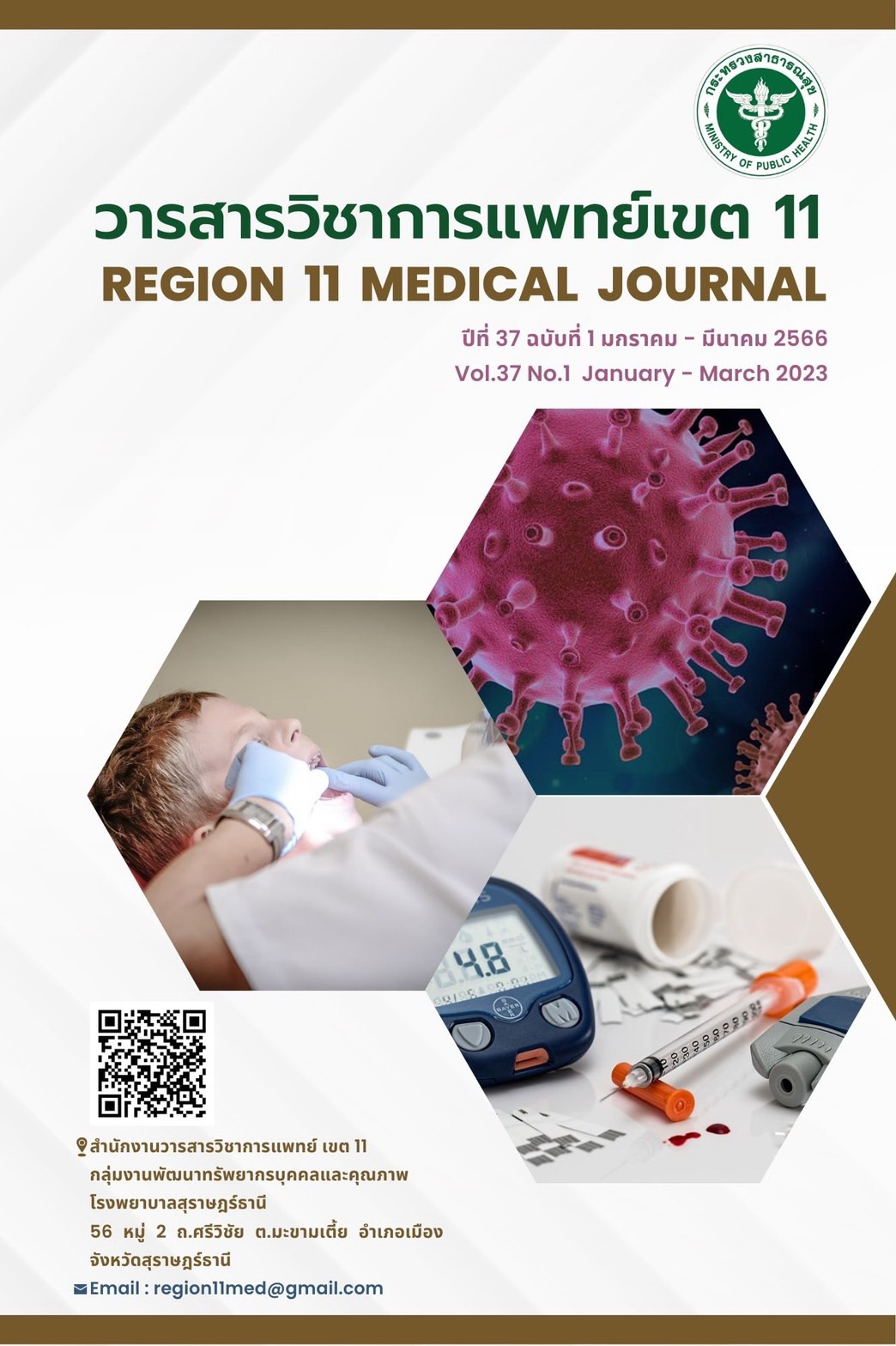The Rehabilitation of Elders’ Frozen Shoulder Joint in Suratthani Hospital
Keywords:
Aging, Frozen Shoulder joint, The relief frozen shoulder setAbstract
Background: Frozen shoulder joint in elders was one of chronic diseases due to degenerative change of tendon and clavicle around the shoulder. It will become calcification and might deform if the disease was prolonged. The severity of frozen shoulder could also cause disability.
Objective: To study the effect of innovation and compare the degree of shoulder joint motion before and after of using recommended exercises in order to develop the satisfaction of the elders who have frozen shoulder joint.
Method: The quasi experimental research was aimed to relief frozen shoulder in elders who are 60 – 69 years old and are the patients in Suratthani Hospital. The samples were selected from the degree of shoulder movement in between 120 to 149 degrees by using Thai arthometric navigator scale or TAN scale. The number of samples was 85 elders. The methodology of this research is consisted of the questionnaire and the relief frozen shoulder exercises from Siriraj medicine and integrative medicine of Mahidol University. Data was analyzed by descriptive statistics and inferential statistics to compare shoulder movement before and after by Paired sample t-test.
Results: The research found that the sample relief frozen shoulder exercises by 10 reps per exercise, 4 exercises, 2 times a day, morning-evening, for 8 weeks. It is accounted for 100 percent. After the elders performed these recommended exercises, the elders have significantly more motions by p <.001. Before shoulder joint workout, the average levels of angle degree were 133.23 and 137.18 accordingly. After the workout, the average levels of angle degree were 158.16 and 161.35 respectively. So, the satisfaction of samples was excellent ( =3.83, S.D. =0.882)
Conclusion: The relief frozen shoulder exercises in elders can rehabilitate and resolve both frozen shoulder movement and increase the statistic satisfaction significantly.
References
สํานักโรคไม่ติดต่อ กระทรวงสาธารณสุข. สถานการณ์การตายและการป่วยด้วยโรคไม่ติดต่อ [อินเทอร์เน็ต] 2557 [เข้าถึงเมื่อ 20 มีนาคม 2560]. เข้าถึงได้จาก: http://www.thaincd. com/ document/ file/download/papermanual/Annual report-2014.pdf.
Morris PE.(2007). Moving our critically ill patients: mobility barriers and benefits. Crit Care Clin. 23: 1-20.
Truong AD, Fan E, Brower RG, NeedlhamDM. .(2009).Review bench-to-bedside review: mobilizing patients in the intensive care unit – from pathophysiology to clinical trials. Crit Care. 13(216): 1-8.
Lin CC, Moseley AM, Refshauge KM, Haas M, Herbert RD. (2016). Effectiveness of joint mobilization after cast immobilization for ankle fracture: a protocol for a randomized controlled trial. BMCMusculoskel Dis 7(46): 1-10.
จิรวรรณชูทิพย์.(2548). ผลเสียของภาวะขาดการเคลื่อนไหวต่อระบบต่างๆของร่างกาย: Bodily response to immobility. ใน: วิภาวรรณลีลาสำราญ, วุฒิชัยเพิ่มศิริวาณิชย์, บรรณาธิการ. การฟื้นฟูผู้ป่วยโรคทางกระดูกและข้อ : Rehabilitation in orthopaedic patients. สงขลา: ชานเมืองการพิมพ์.น. 1-10.
สันติ อัศวพลังชัย. การออกกำลังกายเพื่อการรักษา. ใน: กิ่งแก้วปาจรีย์, บรรณาธิการ. เวชศาสตร์การฟื้นฟูสำหรับเวชปฏิบัติทั่วไป. กรุงเทพมหานคร: ห้างหุ้นส่วนจำกัดเอ็น.พี.เพรสน. 57-66.
Schwartz I, Tsenter J, Shochina M, Shiri S, Kedary M, Katz-Leurer M, et al. .(2007).Rehabilitation outcomes of terror victims with multiple traumas. Arch Phys Med Rehabil. 88: 440
Harding P, Rasekaba T, Smirneos L, Holland AE. (2011). Early mobilization for elbow fractures in adults (reviews). The Cochrane Collaboration. 6: 1-24.
ณชมน สืบซุย, จิราพร ทรงพระ, นุชจรีย์ สิงห์เกิด, รวิภา เครือแสง. (2562). ประสิทธิผลของนวัตกรรมเอสเคโมเดลเพื่อลดอาการข้อไหล่ติดในผู้สูงอายุตำบลแสลงพัน อำเภอวังม่วง จังหวัดสระบุรี. วารสารก้าวทันโลกวิทยาศาสตร์.19(2): 85-101.
Belyea BC, Greenberger HB. (2012). Physical therapy for musculoskeletal conditions. In: Michael AP Editor. Introduction to physical therapy.4th ed. St. Louis, MO: Elsevier Mosby;p. 173-12.
Garzon-Serrano J, Ryan C, Waak K, Hirschberg R, Tully S, Bittner EA, et al. (2011).Early mobilization in critical iii patients: patients’ mobilization level depends on health care provider’s profession. Arch Phys Med Rehabil; 3: 307-31.
Zomorodi M, Topley D, McAnawM..(2012). Developing a mobility protocol for early mobilization of patients in a surgical/trauma icu. Crit Care Res Pract. 1-10.
พรลักษณ์ แพเพชร์เสือโต , ศิริรัตน์ เกียรติกูลานุสรณ์ และนงนุช ล่วงพ้น. ความสัมพันธ์ระหว่างการรับความรู้สึกข้อต่อกับความสามารถในการทรงตัวในผู้สูงอายุ.บูรพาเวชสาร ปีที่ 6 ฉบับที่ 2 กรกฎาคม - ธันวาคม 2562 สาขาวิชากายภาพบำบัด คณะสหเวชศาสตร์ มหาวิทยาลัยบูรพา ชลบุรี ประเทศไทย[ออนไลน์]. เข้าถึงได้จาก https://he01.tci-thaijo.org/index.php/BJmed/article/view/231290. (วันที่ค้นข้อมูล: 25 ตุลาคม 2564).
ปาริฉัตรประจะเนย์(2546). ข้อไหล่ติดแข็ง. วารสารศูนย์บริการวิชาการ.11:11-14
รัชนีกรใจคําสืบ, ชวนพิศแสวงรุจิธรรม, อัมพรพงษ์เทพนิวัติ(2558). วงล้อจักรยานเพื่อเพิ่มองศาการเคลื่อนไหวข้อไหล่สําหรับผู้ป่วยผ่าตัดมะเร็งเต้านมอุตรดิตถ์: โรงพยาบาลอุตรดิตถ์.
รุ่งทิพย์พันธุเมธากุล, สุภาภรณ์ผดุงกิจ, สาวิตรีวันเพ็ญ, จตุรัตน์กันต์พิทยา, ธงชัยประฏิภาณวัตร,มณเฑียรพันธุเมธากุล. (2554). ผลระยะสั้นของการออกกําลังกายแบบชักรอกต่อภาวะข้อ
ลัดดาวัลย์ ชูทองและยามีละ ดอแม.(2564).การพัฒนาความสามารถในการประกอบกิจวัตรประจำวันขั้นพื้นฐานของผู้สูงอายุติดเตียงก่อนและหลังพัฒนาคุณภาพชีวิตด้วยศาสตร์การแพทย์แผนไทย.วารสารวิจัยและพัฒนาวไลยอลงกรณ์ ในพระบรมราชูปถัมภ์ สาขาวิทยาศาสตร์และเทคโนโลยี ปีที่ 16 ฉบับที่ 3 กันยายน - ธันวาคม พ.ศ. 2564 [ออนไลน์]. เข้าถึงได้จากhttps://so06.tci-thaijo.org/index.php/vrurdistjournal/article/view/251413(วันที่ค้นข้อมูล:21ตุลาคม 2564).
Downloads
Published
How to Cite
Issue
Section
License
Copyright (c) 2023 Region11Medical Journal

This work is licensed under a Creative Commons Attribution-NonCommercial-NoDerivatives 4.0 International License.






